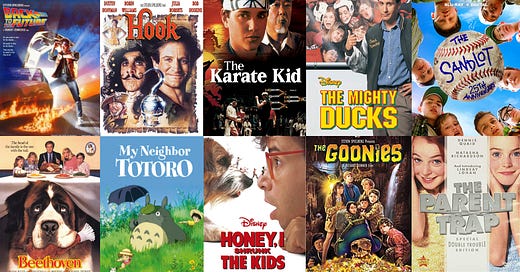Why No One Talks About Movies Anymore (And Why That’s On Us)
Blockbuster Nights, DVD Extras, and the Lost Magic of Movie Sharing
Why don’t we talk about movies anymore? You hear it all the time—a lament from cinephiles scrolling through their feeds or revisiting a long-forgotten gem: “No one ever talks about this movie.” It’s a phrase that implies neglect, a failure of collective memory. But here’s the truth: it’s not that no one talks about movies—it’s that we live in a world where talking about them feels impossible.
The first quarter of this century has brought us approximately 14,000 films. Fourteen thousand. Most of which will remain unknown and unseen. Movies today aren’t cultural touchstones—they’re background noise. Streaming platforms flood us with more options than we could ever hope to watch, let alone discuss. Films aren’t prized possessions anymore; they’re thumbnails on a screen, just another box to check before moving on.
It wasn’t always like this. Once upon a time, movies weren’t just something you watched; they were something you lived. The story didn’t stop when the credits rolled. It carried into your life—Friday nights spent wandering the aisles of Blockbuster, late-night debates with friends about which movie deserved to be rewound and watched again. Back in the golden age of VHS and DVD, movies weren’t just entertainment—they were cultural glue, connecting us through shared experiences and impassioned conversations.
The invention of home video in the 1980s was nothing short of a revolution. Suddenly, movies weren’t confined to theater screens; they became permanent fixtures in our homes, part of the fabric of our lives. That beat-up plastic VHS of The Terminator or Back to the Future wasn’t just a product—it was a portal. Families fought over what to rent because those choices defined the night. You didn’t just rent a tape; you invested your time, money, and weekend plans into it. And when you found a gem? That was the kind of thing you told everyone about.
Then came DVDs in the late ‘90s, ushering in a new era. They weren’t just movies; they were treasure chests. Behind-the-scenes documentaries, director commentaries, pristine digital clarity—it was like being invited into the creative process. DVDs didn’t just preserve movies; they transformed them into experiences. You didn’t just watch a movie; you explored it, learned its secrets, and celebrated its flaws and brilliance in equal measure.
Movies back then weren’t disposable. They mattered. Take The Boondock Saints, for example. The film flopped in theaters, but it became a phenomenon thanks to college kids and Blockbuster shelves. People shared it like a secret handshake, an unspoken code that marked you as part of the club. The film didn’t need a hashtag or a social media campaign—it had people who cared. It had fans.
I remember the first time I saw Kiss Kiss Bang Bang. It was late—2 a.m.—and by the time the credits rolled, I was practically vibrating with excitement. I called my best friend. “You need to see this. Right now,” I said. And he did. He showed up, half-asleep, popcorn in hand. By sunrise, it was one of our favorite movies.
That wasn’t the only time. Once, I walked into a friend’s house, and he was halfway through A Clockwork Orange. I’d never seen it before, but I was mesmerized. When it ended, I was so hooked we rewound it and watched it again, from the beginning. That was his favorite movie, and sharing it wasn’t just an act of friendship—it was a declaration of love for the art form itself.
But today? Today is different.
In the modern era, streaming platforms have shattered the old rituals. Films have become so abundant that most are consumed and forgotten in the blink of an eye. Streaming has made movies accessible, but it’s also made them disposable. The act of sharing a film—handing someone a VHS or DVD, sitting down together to watch it—has been replaced by texting a link or recommending a title in passing. The intimacy is gone.
And then there’s the marketing machine. Social media algorithms prioritize blockbusters, those massive-budget juggernauts with carefully calculated hashtags and endless ads. They dominate the conversation, leaving independent films and smaller gems buried under the noise.
The truth is, the system isn’t built to help us find those hidden treasures anymore. And that’s a problem.
In March 2008, Cloverfield was about to leave theaters. I loved that movie so much I couldn’t let it go quietly. So I organized a viewing party. About 12 people came, including my mom, who hates monster movies but sat through it anyway because she knew it mattered to me. It wasn’t just a night at the movies—it was a shared moment, something fleeting but unforgettable.
That’s the power of film. It doesn’t live in the algorithm or the hype machine—it lives in us, in the way we share it, champion it, keep it alive.
We’ll never go back to the Blockbuster era, and DVDs are relics for most. But the spirit of those times isn’t gone. It’s in every conversation we start, every film we recommend, and every friend we convince to watch something we love.
The sheer number of movies today makes it harder than ever to stand out. But as movie lovers, we have the power to keep the films we care about alive. Whether it’s a cult classic, a forgotten gem, or an indie masterpiece, we can be the ones who carry the torch. Not because it’ll trend, but because it’s worth it.
So be that person. Tell someone, “You need to see this.” Organize a viewing party. Write about it. Share the obscure, champion the underdog. Because if we don’t keep the conversation going, who will?







